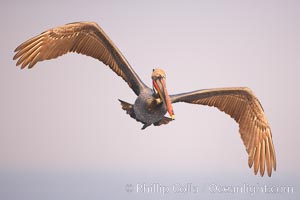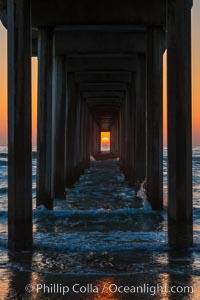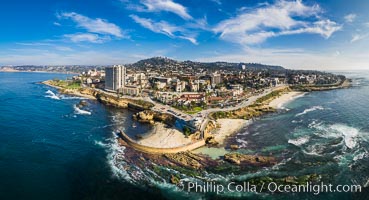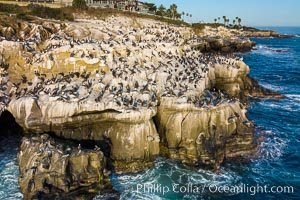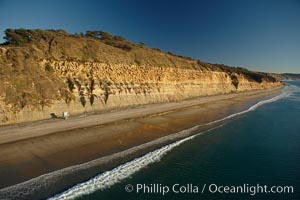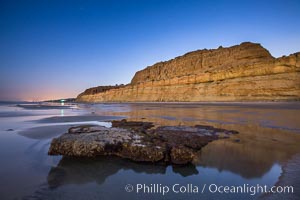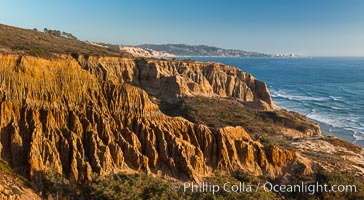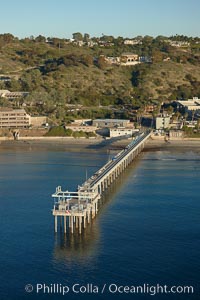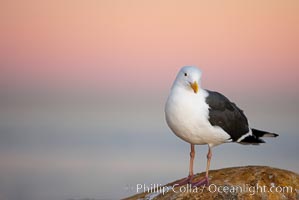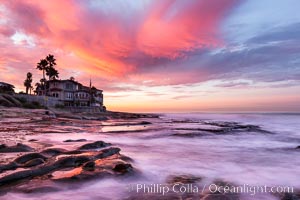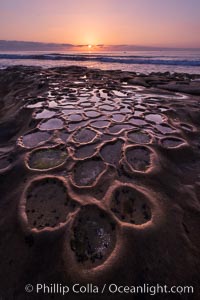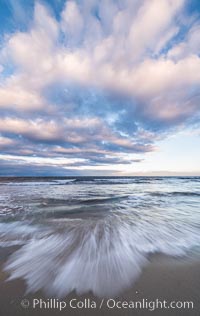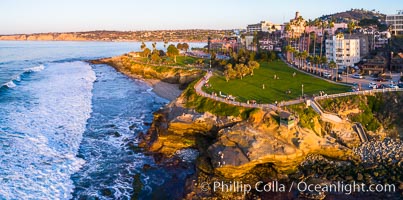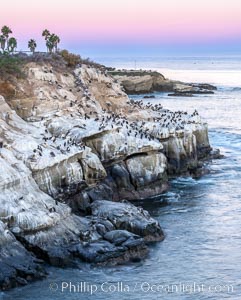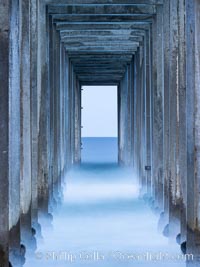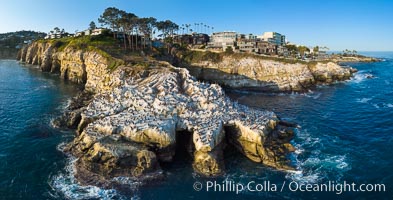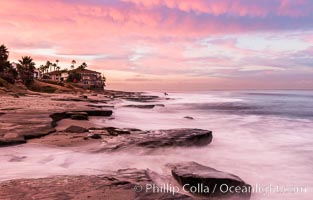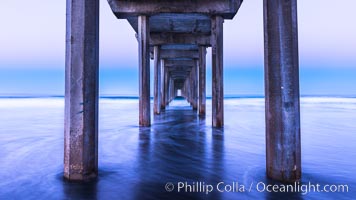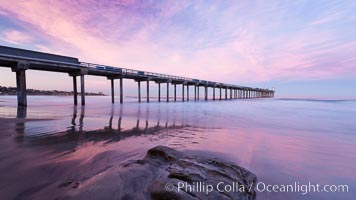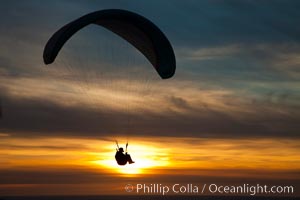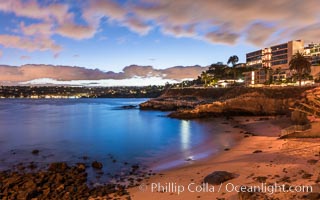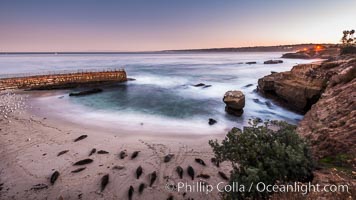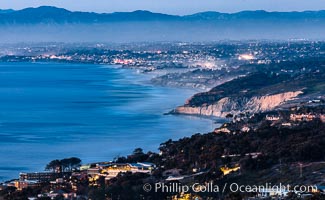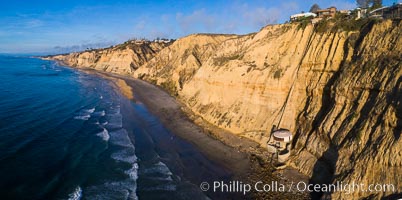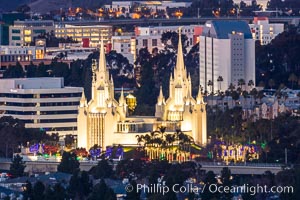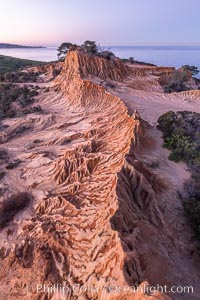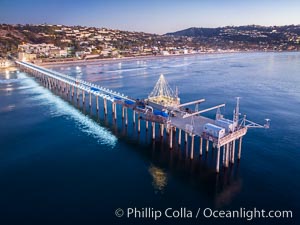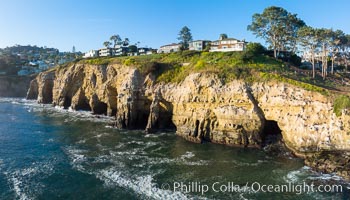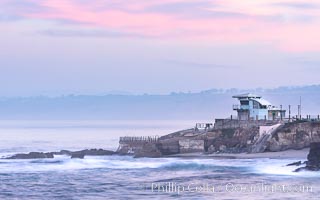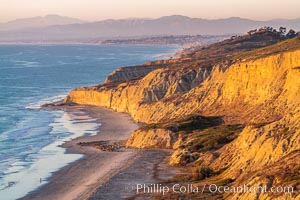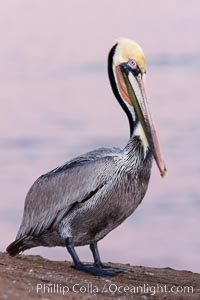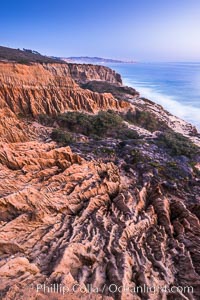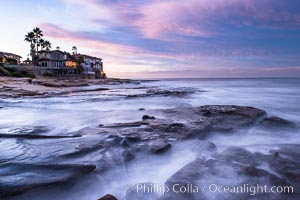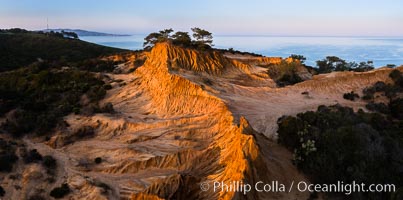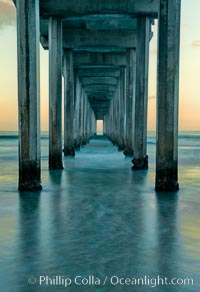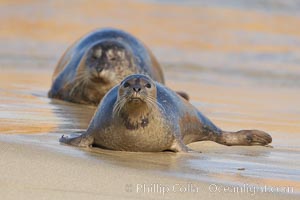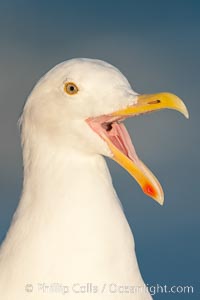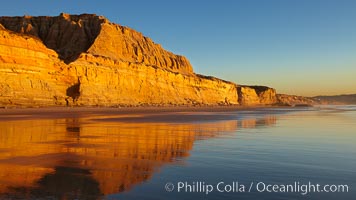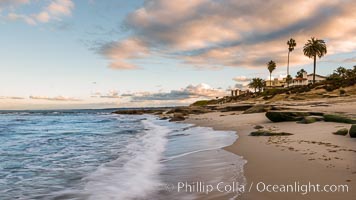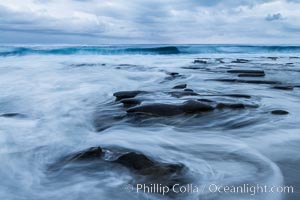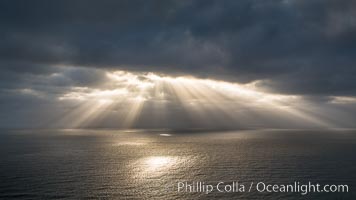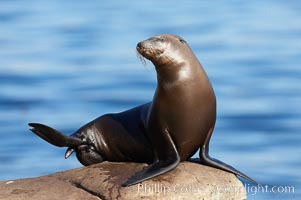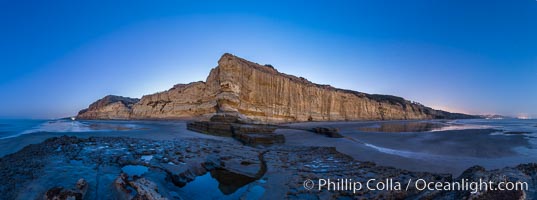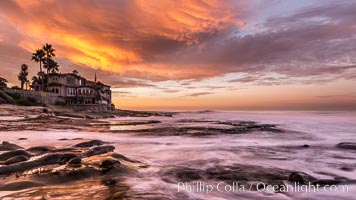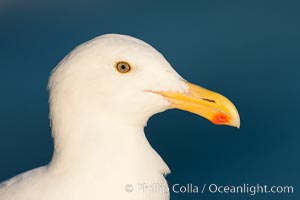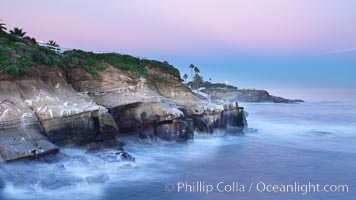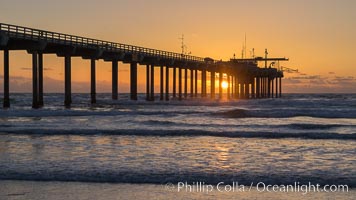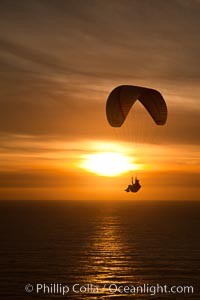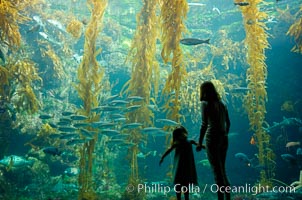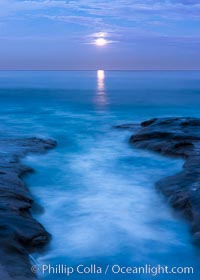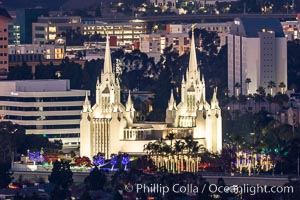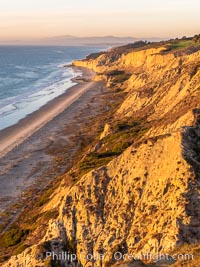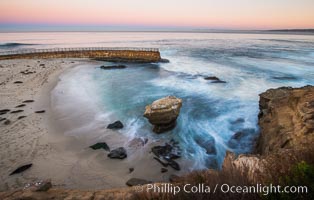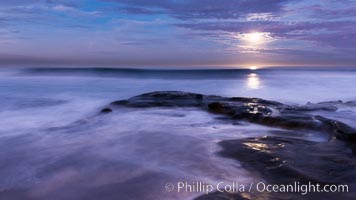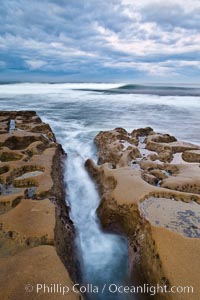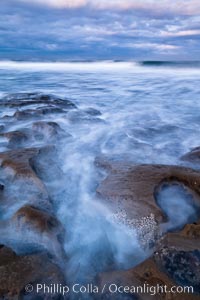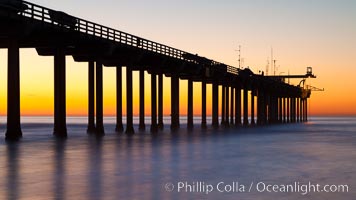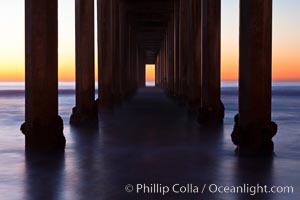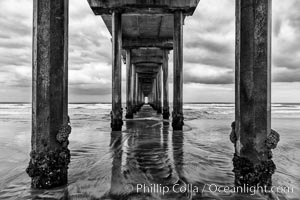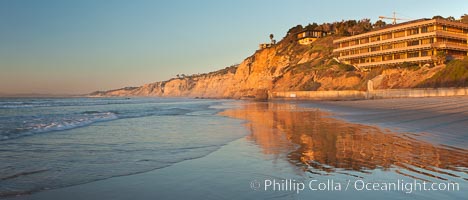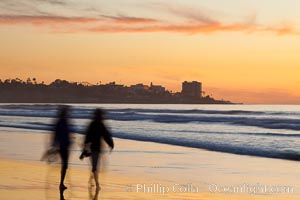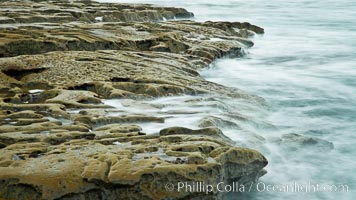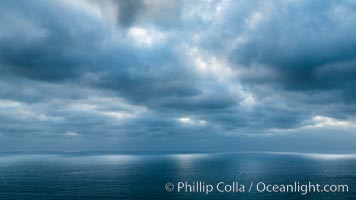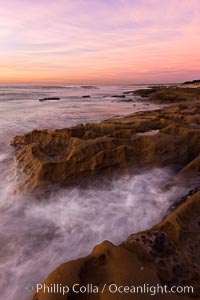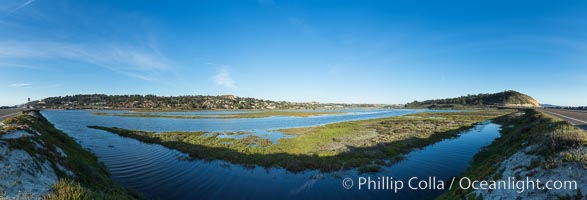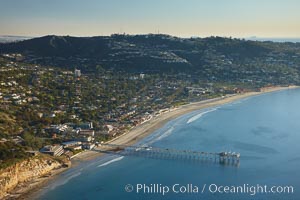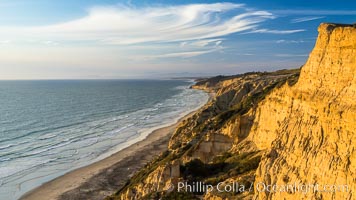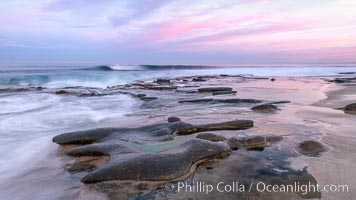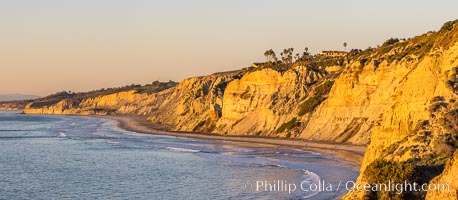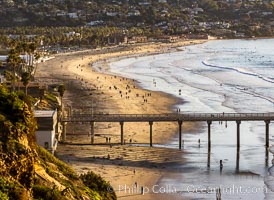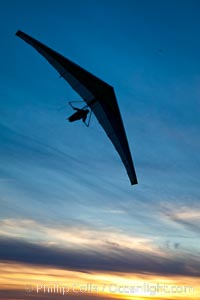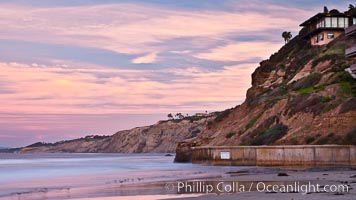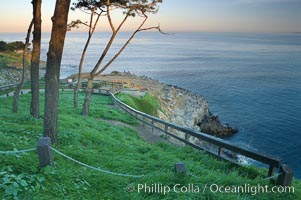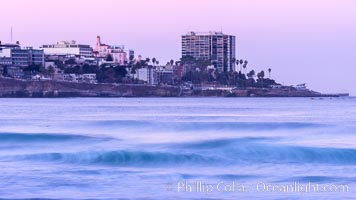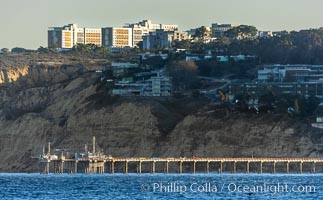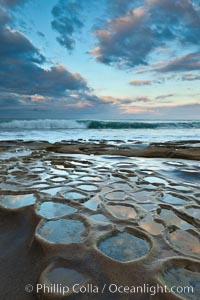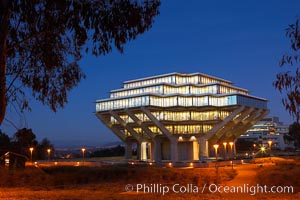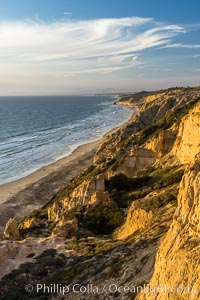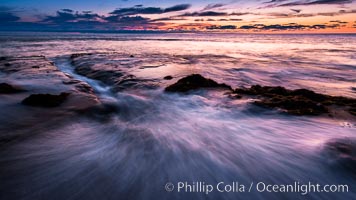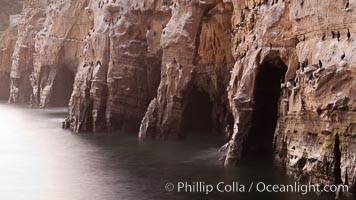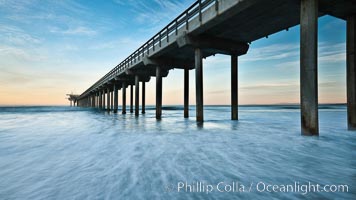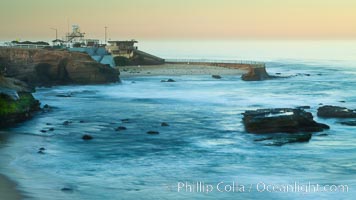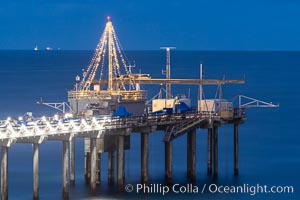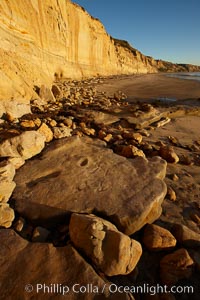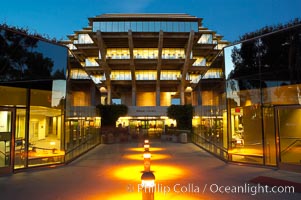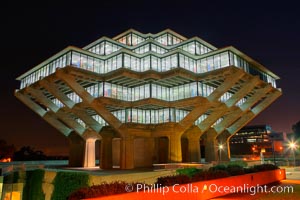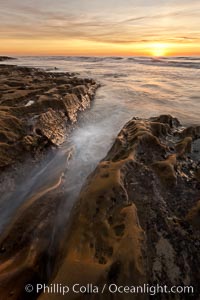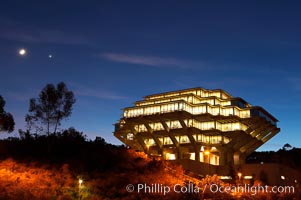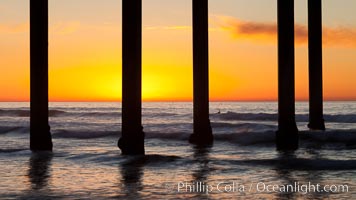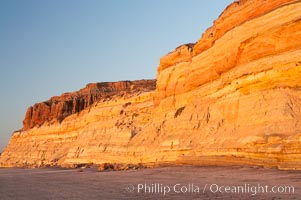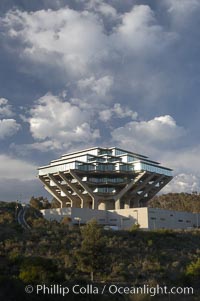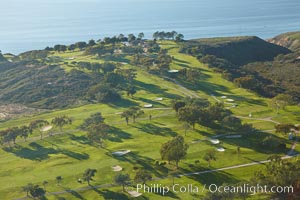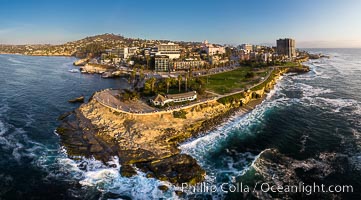
Aerial Panoramic Photo of Point La Jolla at sunset, La Jolla and Mount Soledad. People enjoying the sunset on the sea wall looking at sea lions on the rocks.
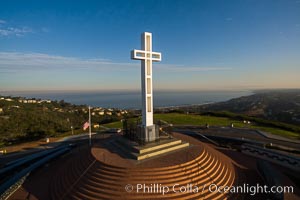
Sunrise over The Mount Soledad Cross, a landmark in La Jolla, California. The Mount Soledad Cross is a 29-foot-tall cross erected in 1954. Aerial photo
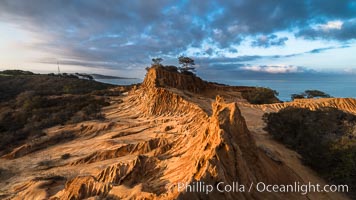
Clearing storm clouds over Broken Hill, overlooking La Jolla and the Pacific Ocean, Torrey Pines State Reserve
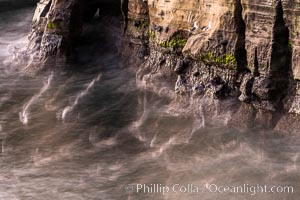
Sea Caves, the famous La Jolla sea caves lie below tall cliffs at Goldfish Point. Sunny Jim Cave. Sunrise. Sea gulls floating int he water blur in this time exposure.
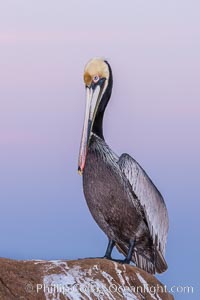
California brown pelican, portrait in pink-purple predawn light, rests on sandstone seabluff. The characteristic mating plumage of the California race of brown pelican is shown, with red gular throat pouch and dark brown hindneck colors.
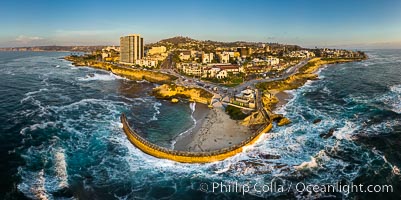
Childrens Pool Aerial Panoramic Photo at Sunset, people enjoying the sunset on the sea wall and the protected beach, Coast Boulevard in the foreground, Mount Soledad in the distance
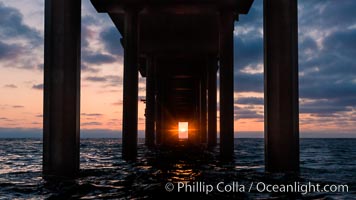
Scripps Pier solstice, surfer's view from among the waves, sunset aligned perfectly with the pier. Research pier at Scripps Institution of Oceanography SIO, sunset.
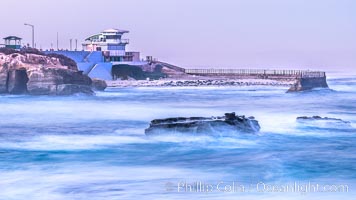
The Children's Pool, also known as Casa Cove, in pre-dawn light, La Jolla. Seal Rock in the foreground.
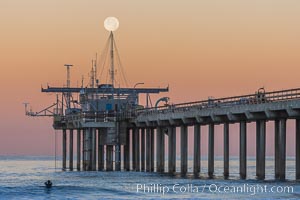
Full Moon Setting Over SIO Pier in the moments just before sunrise, Scripps Institution of Oceanography.
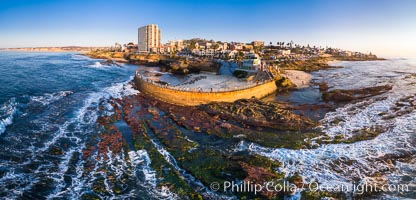
Childrens Pool and La Jolla coastline at sunset, aerial panorama, showing underwater reef exposed at King Low Tide
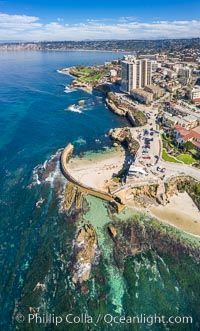
Childrens Pool Reef Exposed at Extreme Low Tide, Aerial View, La Jolla, California. Aerial panoramic photograph.
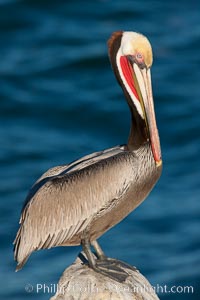
California brown pelican, showing characteristic winter plumage including red/olive throat, brown hindneck, yellow and white head colors.
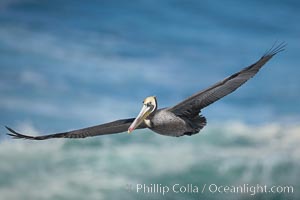
Brown pelican in flight. The wingspan of the brown pelican is over 7 feet wide. The California race of the brown pelican holds endangered species status. In winter months, breeding adults assume a dramatic plumage.
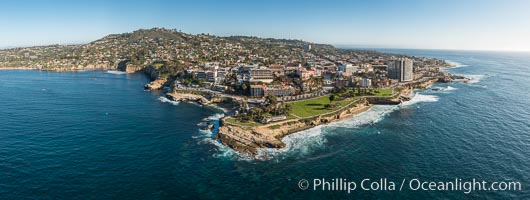
Aerial Panoramic Photo of Point La Jolla and La Jolla Cove, Boomer Beach, Scripps Park. Panoramic aerial photograph of La Jolla Cove and Scripps Parks (center), with La Jolla’s Mount Soledad rising above, La Jolla Shores and La Jolla Caves to the left and the La Jolla Coast with Children’s Pool (Casa Cove) to the right. The undersea reefs of Boomer Beach are seen through the clear, calm ocean waters. This extremely high resolution panorama will print 50″ high by 130″ long with no interpolation
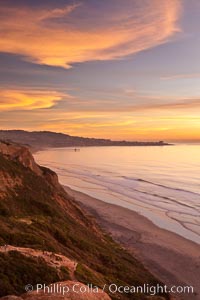
Sunset falls upon Torrey Pines State Reserve, viewed from the Torrey Pines glider port. La Jolla, Scripps Institution of Oceanography and Scripps Pier are seen in the distance.
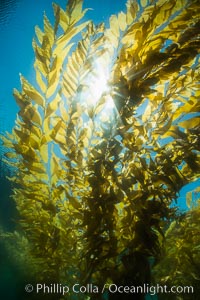
The Kelp Forest offshore of La Jolla, California. A kelp forest. Giant kelp grows rapidly, up to 2' per day, from the rocky reef on the ocean bottom to which it is anchored, toward the ocean surface where it spreads to form a thick canopy. Myriad species of fishes, mammals and invertebrates form a rich community in the kelp forest. Lush forests of kelp are found throughout California's Southern Channel Islands
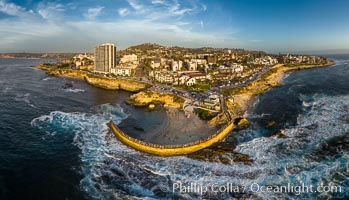
Childrens Pool seawall and Casa Cove aerial photo, La Jolla, California. Sunset. Aerial panoramic photograph.
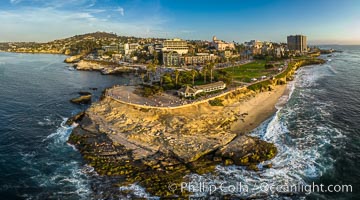
Point La Jolla and Scripps Park aerial photo, sunset, sea lions and sea gulls and tourists looking down on Boomer Beach. Aerial panoramic photo.
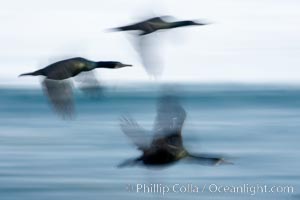
Double-crested cormorants in flight at sunrise, long exposure produces a blurred motion, La Jolla. Phalacrocorax auritus.
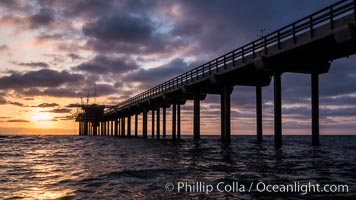
Scripps Pier, Surfer's view from among the waves. Research pier at Scripps Institution of Oceanography SIO, sunset.
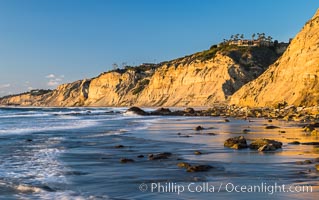
Black's Beach sea cliffs, sunset, looking north from Scripps Pier with Torrey Pines State Reserve in the distance

Aerial Panorama of La Jolla, University City, showing (from left) UCSD, University City, Scripps Institution of Oceanography, La Jolla Shores, Point La Jolla, Mount Soledad, in the background some of the mountains to the east of San Diego. The highest peak in the center of the panoram is Cuyamaca Peak (6512') while the rocky peak directly in front of it is El Cajon Mountain (3675').
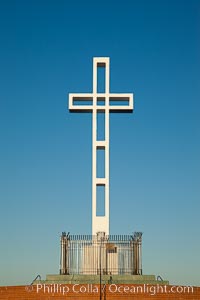
The Mount Soledad Cross, a landmark in La Jolla, California. The Mount Soledad Cross is a 29-foot-tall cross erected in 1954.
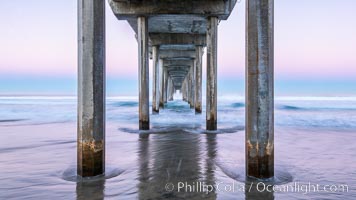
Scripps Institution of Oceanography Pier and Belt of Venus in pre-dawn light. The Earth's shadow appears as the blue just above the horizon.
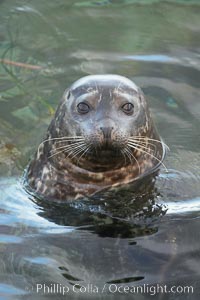
A Pacific harbor seal eyes the photographer while swimming in the shallows. This group of harbor seals, which has formed a breeding colony at a small but popular beach near San Diego, is at the center of considerable controversy. While harbor seals are protected from harassment by the Marine Mammal Protection Act and other legislation, local interests would like to see the seals leave so that people can resume using the beach.
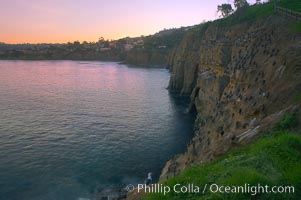
La Jolla Cliffs overlook the ocean with thousands of cormorants, pelicans and gulls resting and preening on the sandstone cliffs. Sunrise with pink skies.
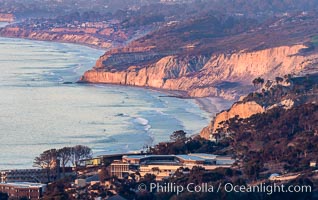
La Jolla Shores Coastline and Scripps Pier, Blacks Beach and Torrey Pines, from Mount Soledad, sunset.
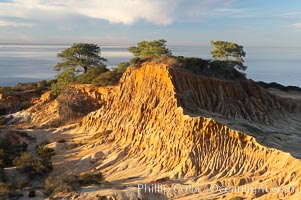
Broken Hill with the Pacific Ocean in the distance. Broken Hill is an ancient, compacted sand dune that was uplifted to its present location and is now eroding.
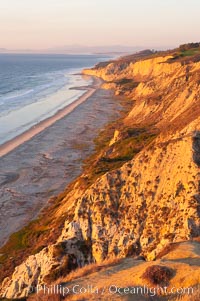
Black's Beach and Sandstone cliffs at Torrey Pines State Park, viewed from high above the Pacific Ocean near the Indian Trail.
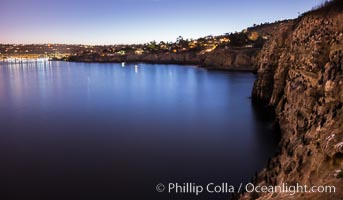
Cormorants rest at night above the La Jolla Caves. La Jolla Sea Caves, the famous La Jolla sea caves lie below tall cliffs at Goldfish Point.
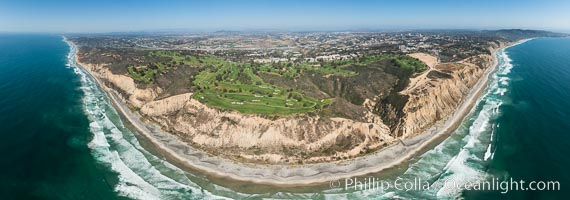
Aerial panorama of Blacks Beach, Torrey Pines Golf Course (south course), and views to La Jolla (south) and Carlsbad (north)
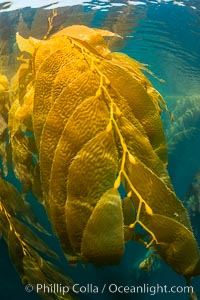
The Kelp Forest offshore of La Jolla, California. A kelp forest. Giant kelp grows rapidly, up to 2' per day, from the rocky reef on the ocean bottom to which it is anchored, toward the ocean surface where it spreads to form a thick canopy. Myriad species of fishes, mammals and invertebrates form a rich community in the kelp forest. Lush forests of kelp are found throughout California's Southern Channel Islands
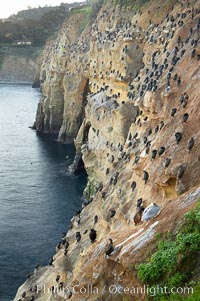
La Jolla Cliffs overlook the ocean with thousands of cormorants, pelicans and gulls resting and preening on the sandstone cliffs.
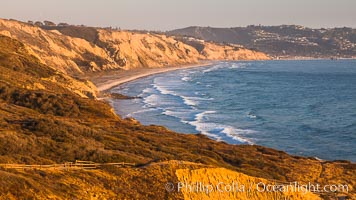
Black's Beach and Torrey Pines Cliffs and Pacific Ocean, Razor Point view to La Jolla, San Diego, California.
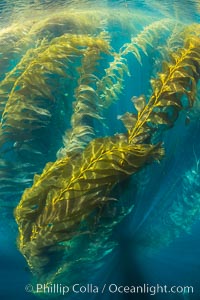
The Kelp Forest offshore of La Jolla, California. A kelp forest. Giant kelp grows rapidly, up to 2' per day, from the rocky reef on the ocean bottom to which it is anchored, toward the ocean surface where it spreads to form a thick canopy. Myriad species of fishes, mammals and invertebrates form a rich community in the kelp forest. Lush forests of kelp are found through California's Southern Channel Islands
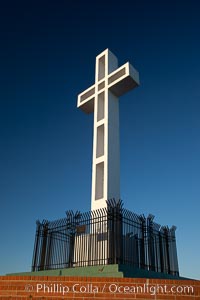
The Mount Soledad Cross, a landmark in La Jolla, California. The Mount Soledad Cross is a 29-foot-tall cross erected in 1954.
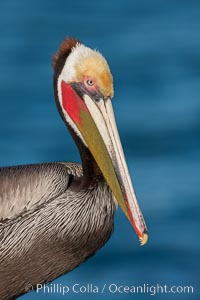
California brown pelican, showing characteristic winter plumage including red/olive throat, brown hindneck, yellow and white head colors.
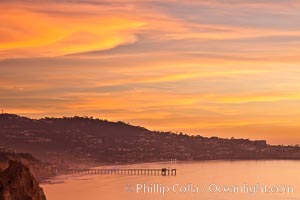
Sunset falls upon Torrey Pines State Reserve, viewed from the Torrey Pines glider port. La Jolla, Scripps Institution of Oceanography and Scripps Pier are seen in the distance.
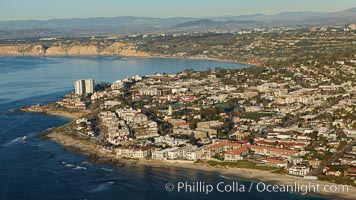
The La Jolla Coast, sometimes referred to as the Riviera of San Diego, is some of the most beautiful residental coastline in all of Southern California.
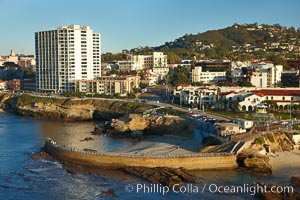
The Children's Pool in La Jolla, also known as Casa Cove, is a small pocket cove protected by a curving seawall, with the rocky coastline and cottages and homes of La Jolla seen behind it.
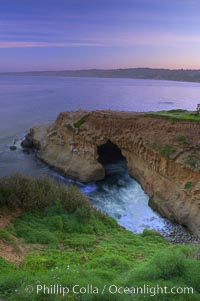
A large natural sea cave lies below a sandstone bluff in La Jolla at sunrise with a pink sky, Black's Beach in the distant.
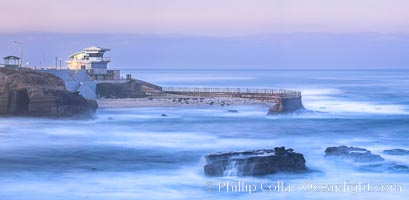
The Children's Pool, also known as Casa Cove, in pre-dawn light, La Jolla. Seal Rock in the foreground
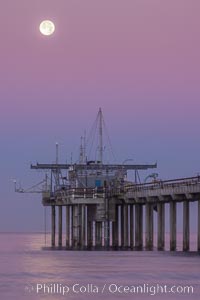
Full Moon Setting Over SIO Pier in the moments just before sunrise, Scripps Institution of Oceanography.
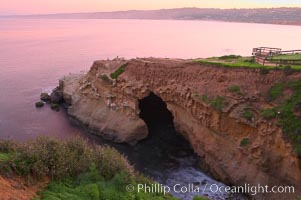
A large natural sea cave lies below a sandstone bluff in La Jolla at sunrise with a pink sky, Black's Beach in the distant.
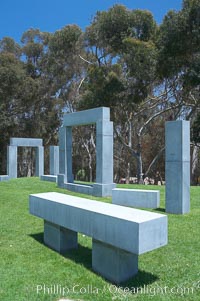
Stonehenge, or what is officially known as the La Jolla Project, was the third piece in the Stuart Collection at University of California San Diego (UCSD). Commissioned in 1984 and produced by Richard Fleishner, the granite blocks are spread on the lawn south of Galbraith Hall on Revelle College at UCSD.
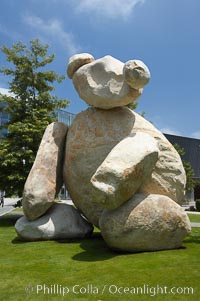
Bear is another of the odd outdoor ""art"" pieces of the UCSD Stuart Collection. Created by Tim Hawkinson in 2001 of eight large stones, it sits in the courtyard of the UCSD Jacobs School of Engineering.
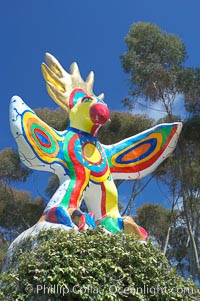
Sun God is a strange artwork, the first in the Stuart Collection at University of California San Diego (UCSD). Commissioned in 1983 and produced by Niki de Sainte Phalle, Sun God has become a landmark on the UCSD campus.
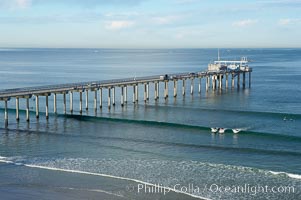
The Scripps Institution of Oceanography research pier is 1090 feet long and was built of reinforced concrete in 1988, replacing the original wooden pier built in 1915. The Scripps Pier is home to a variety of sensing equipment above and below water that collects various oceanographic data. The Scripps research diving facility is located at the foot of the pier. Fresh seawater is pumped from the pier to the many tanks and facilities of SIO, including the Birch Aquarium. The Scripps Pier is named in honor of Ellen Browning Scripps, the most significant donor and benefactor of the Institution.
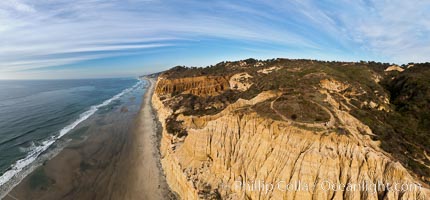
Torrey Pines balloon aerial survey photo. Torrey Pines seacliffs, rising up to 300 feet above the ocean, stretch from Del Mar to La Jolla. On the mesa atop the bluffs are found Torrey pine trees, one of the rare species of pines in the world. Peregine falcons nest at the edge of the cliffs. This photo was made as part of an experimental balloon aerial photographic survey flight over Torrey Pines State Reserve, by permission of Torrey Pines State Reserve.
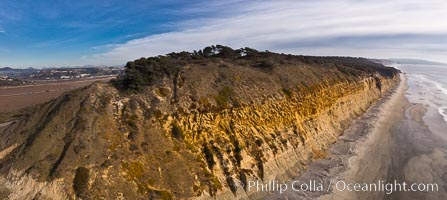
Torrey Pines balloon aerial survey photo. Torrey Pines seacliffs, rising up to 300 feet above the ocean, stretch from Del Mar to La Jolla. On the mesa atop the bluffs are found Torrey pine trees, one of the rare species of pines in the world. Peregine falcons nest at the edge of the cliffs. This photo was made as part of an experimental balloon aerial photographic survey flight over Torrey Pines State Reserve, by permission of Torrey Pines State Reserve.
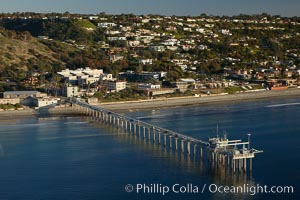
SIO Pier. The Scripps Institution of Oceanography research pier is 1090 feet long and was built of reinforced concrete in 1988, replacing the original wooden pier built in 1915. The Scripps Pier is home to a variety of sensing equipment above and below water that collects various oceanographic data. The Scripps research diving facility is located at the foot of the pier. Fresh seawater is pumped from the pier to the many tanks and facilities of SIO, including the Birch Aquarium. The Scripps Pier is named in honor of Ellen Browning Scripps, the most significant donor and benefactor of the Institution.
